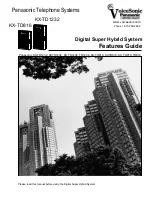
E - 6
Introduction
Important notes on using analogue
equipment
Only analogue Apparatus which are approved to be connected to the Public Switched Tele-
phone Network (PSTN) may be connected to the analogue side of the system.
This includes all 2 wire telephones, answering -, fax machines, and modems.
The system supports both dialling method Loop Disconnect (LD) or Dual Tone Multi
Frequency (DTMF). DTMF is a faster dialling method. The system will dedect the dialling
method automatically.
From an analogue phone, you can call any extension free of charge by dialling the
internal phone number. You can call an external number after seizing an outside line.(B
channel) Do do this dial 9 (0) to get an outside line and then dial the telephone number
required.
If you set “spontaneous exchange line seizure with internal ” for your telephone extension
then you must press the hash button before the internal phone number. Note in this mode
you cannot call an extension if your phone is an older LD or rotary type dial phone.
To carry out system functions, your phone must have a STAR Button (*). The sequence to
enter will be * followed by the function number. If your phone is an older type LD phone
then you can dial 99 instead of * .
Your phone must have an R Button (Recall Button) to make an enquiry call . The signalling
for this must be set to Timed Break Recall (TBR). On older rotary dial phones you do not
need to press the R Button when making an enquiry call. System functions such as last
number redial, abbreviated dialling etc, can be carried out from any LD phone. Details of
such operations are given in this manual and in the short reference guide under
Analogue and ISDN Terminals.
You can also use the functions of a standard analogue telephone (e.g. redial, abbreviated
dialling) in conjunction with your telephone system. Please refer to the operating
instructions for the telephone concerned for details of these functions.
Details on how to access features of your telephone system via a standard telephone are
available in this user manual and in the ‘short version’ of the operating instruction under
Analogue and ISDN terminals.
Each programming entry will be acknowledged by a confirmation tone. If this tone is not
received or if an error tone is returned then you must repeat this entry.
The telephone system is forwarding counting pulses to analogue terminals to display
connection charges (charge pulses).
For data transfer via the analogue ports, the telephone system supports the V.90 standard
(up to 56600 bps, a reduction in speed is possible due to transmission path and cables
used, down to 33600 bps V.34+).When operating a modem, it is imperative to configure the
modem to blind dialling because most modems do not detect the dial tone of a telephone
system.On modems that operate with the Hayes command set, blind dialling is set by
means of the X0..X4 parameters.
Summary of Contents for AS 181 plus
Page 1: ...Manual Basic Line AS 181 ISDN PBX System...
Page 24: ...1 2 System Telephones ST 25 DECT 30 ST 30...
Page 119: ...1 97 System Telephones ST 25 DECT 30 ST 30...
Page 120: ...2 2 Analogue and ISDN Phones...
Page 169: ...2 51 Analogue and ISDN Phones...
Page 170: ...3 2 Programming your System ST 25 DECT 30 ST 30...
Page 190: ...Communication via PC PC 2...
Page 199: ...Communication via PC PC 11...
Page 215: ...S 5 Index...
Page 216: ...S 6 Index...
Page 218: ...S 8 Index Declaration of Conformity...
Page 219: ...S 9 Index...
























